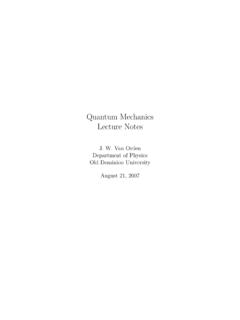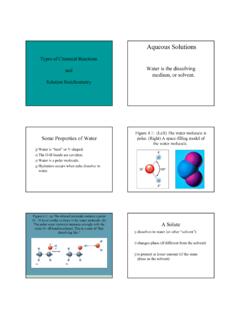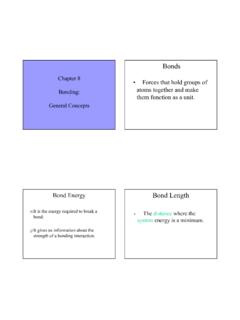Transcription of The Localized Electron Model Chapter 9 Covalent Bonding ...
1 1 Chapter 9 Covalent Bonding :OrbitalsThe Localized Electron Model Draw the Lewis structure(s) Determine the arrangement of Electron pairs (VSEPR Model ). Specify the necessary hybrid Bond Theory Valence bond theory or hybrid orbital theoryis an approximate theory to explain the Covalent bond from a quantum mechanical view. According to this theory, a bond forms between two atoms when the following conditions are met. (see Figures and )1. Two atomic orbitals overlap 2. The total number of electrons in both orbitals is no more than The mixing of atomic orbitals to form special orbitals for Bonding . The atoms are responding as needed to give the minimum energy for the : Formation of H2.
2 Bond formed between two s orbitalsFigure : Bonding in HCl. Bond formed between an s and p orbitalHybrid orbitals One might expect the number of bonds formed by an atom would equal its unpaired electrons. Chlorine,for example, generally forms one bond and has one unpaired Electron . Oxygen, with two unpaired electrons, usually forms two bonds. However, carbon, with only two unpaired electrons, generally forms four bonds. For example, methane, CH4, is well : (a) The Lewis structure of the methane molecule. (b) The tetrahedral molecular geometry of the methane orbitals The Bonding in carbon might be explained as follows: Four unpaired electrons are formed as an Electron from the 2s orbital is promoted(excited) to the vacant 2p orbital.
3 The following slide illustrates this excitation. (Recall that in the excited state for an element, a ground state Electron is promoted to a higher orbital) More than enough energy is supplied for this promotion from the formation of two additional Covalent atom (ground state)2s2pEnergy2s2p1s1sC atom (promoted)Hybrid orbitals One bond on carbon would form using the 2s orbital while the other three bonds would use the 2p orbitals . This does not explain the fact that the four bonds in CH4appear to be identical. Valence bond theory assumes that the four available atomic orbitals in carbon combine to make four equivalent hybrid orbitals Hybrid orbitalsare orbitals used to describe Bonding that are obtained by taking combinations of atomic orbitals of an isolated atom.
4 In this case, a set of hybrids are constructed from one s orbital and three p orbitals , so they are called sp3hybrid orbitals . The four sp3hybrid orbitals take the shape of a tetrahedron(see Figure ).4 Figure : The valence orbitals on a free carbon atom: 2s, 2px, 2py, and : The "native" 2sand three 2patomic orbitals characteristic of a free carbon atom are combined to form a new set of four sp 3orbitals. The small lobes of the orbitals are usually omitted from diagrams for : Cross section of an : The tetrahedral set of four sp3orbitals of the carbon atom are used to share Electron pairs with the four 1sorbitals of the hydrogen atoms to form the four equivalent C H bonds.
5 This accounts for the known tetrahedral structure of the CH4 : The nitrogen atom in ammonia is : An energy-level diagram showing the formation of four can represent the hybridization of carbon in CH4as atom (ground state)Energy1s2p2ssp31ssp31sC atom (hybridized state)C atom (in CH4)C-H bondsA Problem to Consider Describe the Bonding in H2O according to valence bond theory. Assume that the molecular geometry is the same as given by the VSEPR Model . From the Lewis formulafor a molecule, determine its geometry about the central atom using the VSEPR Model . 6A Problem to Consider Describe the Bonding in H2O according to valence bond theory. Assume that the molecular geometry is the same as given by the VSEPR Model .
6 The Lewis formula for H2O is A Problem to Consider Describe the Bonding in H2O according to valence bond theory. Assume that the molecular geometry is the same as given by the VSEPR Model . From this geometry, determine the hybridorbitals on this atom, assigning its valence electrons to these orbitals one at a time. A Problem to Consider Describe the Bonding in H2O according to valence bond theory. Assume that the molecular geometry is the same as given by the VSEPR Model . Note that there are four pairs of electrons about the oxygen atom. According to the VSEPR Model , these are directedtetrahedrally, and from the previous table you see that you should use sp3hybrid Problem to Consider Describe the Bonding in H2O according to valence bond theory.
7 Assume that the molecular geometry is the same as given by the VSEPR Model . Each O-Hbond is formed by the overlap of a 1s orbitalof a hydrogen atom with one of the singly occupied sp3hybrid orbitalsof the oxygen can represent the Bonding to the oxygen atom in H2O as follows:O atom (ground state)Energy1s2p2ssp31ssp31sO atom (hybridized state)O atom (in H2O)O-H bondslonepairsFigure : Bonding in H2O. Figure : An orbital energy-level diagram for sp2hybridization. Note that one porbital remains : The hybridization of the s, px, and pyatomic orbitals results in the formation of three sp2orbitals centered in the xyplane. The large lobes of the orbitals lie in the plane at angles of 120 degrees and point toward the corners of a : When one sorbital and one porbital are hybridized, a set of two sporbitals oriented at 180 degrees : A set of dsp3hybrid orbitals on a phosphorus atom.
8 Note that the set of five dsp3orbitals has a trigonal bipyramidal arrangement. (Each dsp3orbital also has a small lobe that is not shown in this diagram.)Figure : (a) The structure of the PCI5 molecule. (b) The orbitals used to form the bonds in PCl5. The phosphorus uses a set of five dsp3 orbitals to share Electron pairs with sp3 orbitals on the five chlorine atoms. The other sp3 orbitals on each chlorine atom hold lone : An octahedral set of d2sp3orbitals on a sulfur atom. The small lobe of each hybrid orbital has been omitted for orbitals Note that there is a relationship between the type of hybrid orbitalsand the geometric arrangementof those orbitals . Thus, if you know the geometric arrangement, you know what hybrid orbitals to usein the Bonding description.
9 Figure summarizes the types of hybridization and their spatial : The relationship of the number of effective pairs, their spatial arrangement, and the hybrid orbital set OrbitalsS in SF66 Octahedrald2sp3P in PCl55 Trigonal bipyramidaldsp3C in CH44 Tetrahedralsp3B in BF33 Trigonal planarsp2Be in BeF22 LinearspExampleNumber of OrbitalsGeometric ArrangementsHybrid OrbitalsHybrid orbitals To obtain the Bonding description of any atom in a molecule, you proceed as follows:1. Write the Lewis Electron -dot formulafor the From the Lewis formula, use the VSEPR theory to determine the arrangement of Electron pairsaround the orbitals To obtain the Bonding description of any atom in a molecule, you proceed as follows:3.
10 From the geometric arrangement of the Electron pairs, obtain the hybridization electronsto the hybrid orbitals of this atom one at a time, pairing only when orbitals To obtain the Bonding description of any atom in a molecule, you proceed as follows:5. Form bonds to this atom by overlapping singly occupied orbitals of other atoms with the singly occupied hybrid orbitals of this Problem to Consider Describe the Bonding in XeF4using hybridorbitals. From this geometry, determine the hybridorbitalson this atom, assigning its valence electrons to these orbitals one at a time. A Problem to Consider Describe the Bonding in XeF4using hybridorbitals. From the Lewis formula for a molecule, determine its geometry about the central atom using the VSEPR Model .

















